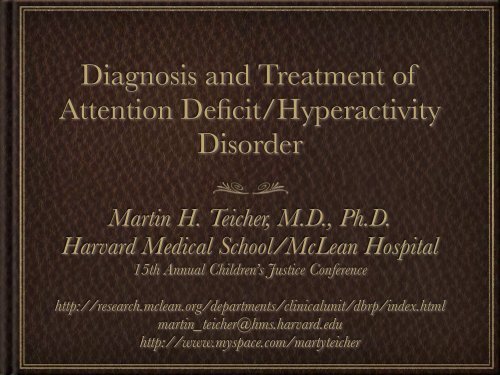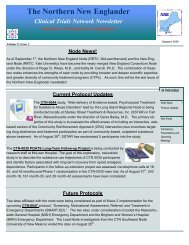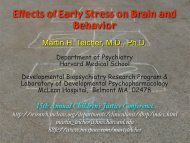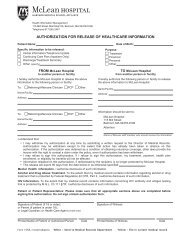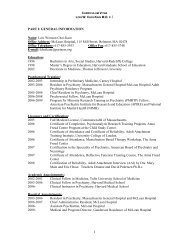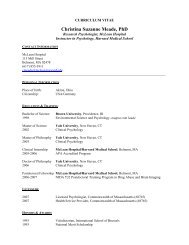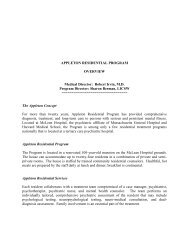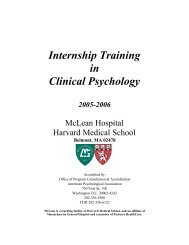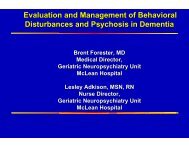Diagnosis and Treatment of Attention Deficit ... - McLean Hospital
Diagnosis and Treatment of Attention Deficit ... - McLean Hospital
Diagnosis and Treatment of Attention Deficit ... - McLean Hospital
You also want an ePaper? Increase the reach of your titles
YUMPU automatically turns print PDFs into web optimized ePapers that Google loves.
ADHD - OpinionDoesn’texist!Almosteveryonefindsthemselveshere.Drugcompany&APAconspiracy
ADHDYes, it exits!But no, you don’t have it!
DisclaimerDuring the course <strong>of</strong> this talk I will be discussing patentedtechnologies - the <strong>McLean</strong> Motion <strong>and</strong> <strong>Attention</strong> Test (M-MAT), <strong>and</strong> certain imaging methods that I invented, orco-invented. These technologies have been licensed toBioBehavioral Diagnostics, Inc. by <strong>McLean</strong> <strong>Hospital</strong>,which owns the patents. I have no equity or position inthis company, <strong>and</strong> receive no consulting fees. I do havethe potential to receive royalties, in keeping with conflict <strong>of</strong>interest policies established by Harvard Medical School<strong>and</strong> Partners Health Care.
<strong>Attention</strong>-<strong>Deficit</strong>/Hyperactivity DisorderADHD is recognized world-wide as one <strong>of</strong> themost common neuropsychiatric disorders <strong>of</strong>childhood. It has been estimated to affectbetween 2% <strong>and</strong> 9% <strong>of</strong> school-age children --with most recent studies indicating a prevalence <strong>of</strong>approximately 6%.ADHD accounts for 30% - 50% <strong>of</strong> child referralsto mental health services.
Assessment
AssessmentHow ADHD is assessed in clinical practice (DMS-IV criteria).What’s wrong with how it is assessed.How might assessment be improved (M-MAT).
InattentionImpulsivityHyperactivity
Diagnostic Criteria - DSM IVA. Either (1) or (2):(1) Six (or more) <strong>of</strong> the following symptoms <strong>of</strong> inattentionhave persisted for at least 6 months to a degree that ismaladaptive <strong>and</strong> inconsistent with developmental level(2) Six (or more) <strong>of</strong> the following symptoms <strong>of</strong> hyperactivity -impulsivity have persisted for at least 6 months to a degree thatis maladaptive <strong>and</strong> inconsistent with developmental level:
Diagnostic Criteria - DSM IVInattention - 6 or more1. Often fails to attend to details2. Often has difficulty sustaining attention3. Often does not seem to listen4. Often fails to finish tasks5. Often has difficulty organizing tasks6. Often avoids sustained mental effort7. Often looses things necessary for tasks8. Is <strong>of</strong>ten distracted by extraneous stimuli9. Is <strong>of</strong>ten forgetful
Diagnostic Criteria - DSM IVHyperactivity & Impulsivity - 6 or more1. Often fidgets with h<strong>and</strong>s or feet2. Leaves seat in classroom when expected to stay seated3. Often runs about or climbs excessively4. Often has difficulty playing quietly5. Often “on the go” or “driven by a motor”6. Often talks excessively7. Often blurts out answers8. Often has difficulty awaiting turn9. Often interrupts or intrudes
Diagnostic Criteria - DSM IVB. Some hyperactive-impulsive orinattentive symptoms that causedimpairment were present before age 7.C. Some impairment from thesymptoms is present in two or moresettings (e.g., at school <strong>and</strong> at home).
Diagnostic Criteria - DSM IVD. There must be clear evidence <strong>of</strong> clinicallysignif icant impairment in social, academic, oroccupational functioning.E. The symptoms do not occur exclusivelyduring the course <strong>of</strong> a Pervasive DevelopmentalDisorder, Schizophrenia or other Psychoticdisorder, <strong>and</strong> are not better accounted for byanother mental disorder (e.g., Mood Disorder,Anxiety Disorder, Dissociative Disorder, or aPersonality Disorder).
CriticismsCriteria are entirely behavioralA patient is diagnosed with ADHD if he/shebehaves in a manner in which we expect someonewith ADHD to behave.Some children with ADHD (particularly girls)may not behave enough like the typical ADHDchild to meet diagnostic criteria.
CriticismsCriteria are entirely behavioralSome children who really do not have ADHDmay behave in a manner similar enough to meetdiagnostic criteria (e.g., conduct disorder, bipolar,PTSD, learning disorder, medication side-effect,etc.)
CriticismsCriteria are entirely behavioralNeed to distinguish between children who fail tosit still <strong>and</strong> pay attention because they lack theability, <strong>and</strong> those who behave in that manner buthave the ability.
CriticismsCriteria are committee-based <strong>and</strong> arbitraryCriteria are some what arbitrary, <strong>and</strong> changeevery several years as the diagnostic criteria arerevised.With each revision the disorder becomes moreprevalent, as criteria becomes less restrictive.
ICD-10 Criteria • Hyperkinetic DisorderICD-10 Inattention (6 or more) + Impulsivity (1 or more) + Hyperactivity (3 or more)DSM-IV Inattention (6 or more) or Hyperactivity-impulsivity (6 or more)1. Fails to attend to details 1. Blurts out answers2. Has difficulty sustaining attention 2. Difficulty awaiting turn3. Does not seem to listen 3. Interrupts or intrudes4. Fails to finish 4. Talks excessively (ICD-10) 4. Talks excessively (DSMIV)5. Has difficulty organizing tasks 5. Fidgets with h<strong>and</strong>s or feet6. Avoids sustained effort 6. Leaves seat in classroom7. Looses things 7. Runs about or climbs8. Is distrated by extraneous stimuli 8. Difficulty playing quitely9. Is forgetful 9. Motor excess ('on the go')
CriticismsThe disorder is misnamed“…the evidence…is that there is no attentiondeficit in this disorder. If what you mean byattention is the following: the ability to perceive,detect, filter <strong>and</strong> process information”. Barkley
CriticismsThe disorder is misnamed“All the evidence is on the output side <strong>of</strong> thebrain, the way behavior is being organized,inhibited, planned, executed <strong>and</strong> protected fromdisruption”. BarkleyDSM-IV committee was going to rename thedisorder ‘Behavioral Inhibition Disorder’.
CriticismsCriteria are not age-adjustedDSM-IV criteria validated in children from 4 - 16years <strong>of</strong> age.Symptoms (<strong>and</strong> number <strong>of</strong> required items) notappropriate for adults (or younger children).
CriticismsCriteria are not gender specificDSM-IV criteria validated mostly in boys (subject pool84% male).DSM-IV requires girls to meet the same requirement forDx as boys.Does not account for the fact that baseline for normalgirls is quite different than the baseline for normal boys.
CriticismsPredominantly Inattentive Subtype is anUnrelated DisorderOpposite symptoms -- instead <strong>of</strong> beinghyperactive, intrusive, distractible, they’relethargic, slow-moving, hypoactive, spacey,daydreamy, passive, withdrawn, <strong>and</strong> in a fog.
CriticismsPredominantly Inattentive Subtype is anUnrelated DisorderUnlike Combined or Hyperactive-ImpulsiveSubtype the Inattentive subtype has an“input problem” - difficulty with selectiveattention <strong>and</strong> speed <strong>of</strong> processing incominginformation plus they have memoryproblems.
CriticismsPredominantly Inattentive Subtype is anUnrelated DisorderCombined <strong>and</strong> Hyperactive-Impulsivesubtypes are closely associated withOppositional Defiant Disorder <strong>and</strong> ConductDisorder. This is not true for children withthe Inattentive subtype. This subtype doesnot fit amongst the ‘disruptive disorders’.
CriticismsPredominantly Inattentive Subtype is anUnrelated DisorderOnly about 20% <strong>of</strong> the Inattentive subtypeshow good clinical response to stimulants(low doses). 90% <strong>of</strong> Combined orHyperactive-Impulsive children respondwell to stimulants (moderate to high doses).
CriticismsPredominantly Inattentive Subtype is anUnrelated DisorderOften this is a wastebasket category - somehave this subtype others have depression,anxiety disorders, undiagnosed learningdisorders, substance abuse disorders,borderline IQ.
CriticismsPredominantly Inattentive Subtype is anUnrelated DisorderGirls with ADHD are not usually (contrary to whatyou hear or read) ‘Predominantly Inattentive’.Objective measures show that they are as hyperactiveas boys with ADHD. Teachers rate them as muchmore hyperactive-impulsive than normal girls, but nomore hyperactive-impulsive than normal boys.
Validity <strong>of</strong> DSM-IV CriteriaThis was assessed by having a panel <strong>of</strong> ADHD expertsindependently ascertain in their best opinion whether aset <strong>of</strong> children did or did not have ADHD. They hadaccess to highly detailed transcribed clinicalinformation on each child. They were not required touse any specific criteria for ADHD, but to diagnoseeach child based on their best conceptualization <strong>of</strong> thedisorder. DSM-IV criteria were then applied to theexact same data set.Concordance was 0.59 (for combined, hyperactive -impulsive subtypes) <strong>and</strong> 0.47 (inattentive subtype).
Validity <strong>of</strong> DSM-IV CriteriaDSM-IV was designed to provide a convenient <strong>and</strong>reliable (i.e., consistent) basis for diagnosis. We knowrelatively little about the validity <strong>of</strong> these criteria as atrue psychiatric or neurobiological taxonomy.Costellanos <strong>and</strong> Tannock (2002) have appropriatelysummarized the situation stating that “… ADHD hasbeen reified “as an ontological <strong>and</strong> psychologicalreality, rather than just a useful clinical construct...”
RecommendationReconceptualize ADHD as a functionaldisability.In children, it would be a diminished orimpaired ability to inhibit motor activity <strong>and</strong>impulsive behaviors, <strong>and</strong> to persist in theperformance <strong>of</strong> tasks that require selfmotivation<strong>and</strong> self-regulation.
GOAL: MMATTo develop a rapid <strong>and</strong> reliablemedical test that can aidclinicians so they can moreaccurately diagnose patientswith ADHD, <strong>and</strong> can betterevaluate whether selectedtreatments are helpful.
Value <strong>of</strong> Objective MeasuresYou could assess myopia in children with teacher <strong>and</strong>parent ratings - do they squint? How close do they sitto the TV?But that would depend on where they sit in class, thesize <strong>of</strong> the teacher’s writing, or the size <strong>of</strong> your TVscreen. There is enormous value in st<strong>and</strong>ardizedquantitative assessment.
Variability in ADHD Symptoms
MMAT - DevelopmentSigns <strong>and</strong> symptoms that most accurately distinguishADHD from other disorders (DSM-IIIR, APA, 1987).Often fidgets with h<strong>and</strong>s or feet or squirmsin seatHas difficulty remaining seated whenrequired to do soIs easily distracted by extraneous stimuli
StrategyProvide an <strong>of</strong>fice-based assessment instrument for the objectivemeasures <strong>of</strong> hyperactivity, impulsivity <strong>and</strong> inattention.HyperactivityThis is a bit <strong>of</strong> a misnomer. Children with ADHD are no moreactive than normal children during recess. The “hyperactivity”<strong>of</strong> the ADHD child is an impaired ability to inhibit activity tolow levels (i.e.,to sit still).•Use a high-resolution motion analysis system to capturetheir fidgetiness during a monotonous attention task.
ImpulsivenessImpulsivity in ADHD is a consequence <strong>of</strong> an impaired ability toinhibit behavioral responses (acting before thinking).•Assess this parameter using an attentional task thatelicits rapid responses.InattentionChildren with ADHD receive <strong>and</strong> process information normally.Their problem with “attention” stems from distractability(inability to inhibit attending to irrelevant stimuli) <strong>and</strong>susceptibility to boredom.•Assess their degree <strong>of</strong> distraction by using a monotonoustask that provides no feedback or reward.
Internettrans.foranalysis
Ecological Validity
School Study I n=698Connors Teacher Ratings20151050BoysHyperactiveNot Hyperp < 10 -8 p < 10 -5Girls
ADHD - GirlsGirls with ADHD have activity disturbances on M-MAT that are very similar to those in boys. They moveas <strong>of</strong>ten, but cover a slightly smaller area.Humans rating hyperactivity are markedlyinfluenced by the nature <strong>of</strong> the behaviors observed. Weoverrate aggressive behaviors, underrate sociallyacceptable behaviors.
Adult (M) - Normal ControlAdult (M) - ADHD
Adult (F) - Normal ControlAdult (F) - ADHD
Improved <strong>Attention</strong> TestIn our original research we used a TOVA-based attentiontest. The TOVA was designed to be useful with dyslexicchildren, <strong>and</strong> it uses solid squares at either the the inner top orinner bottom <strong>of</strong> a central rectangle (Square Test) instead <strong>of</strong>letters. All previous CPTs had used letters presented at thecenter <strong>of</strong> the screen.
Improved <strong>Attention</strong> Test
Improved <strong>Attention</strong> TestWe created a new CPT using r<strong>and</strong>omly positioned 8 pointed <strong>and</strong>5 pointed stars as targets / non-targets. This was done to preventcheating, but there was an important additional benefit.Humans have two visual attention systems:1) Highly focused foveal system for detaileddiscrimination. Largely left frontal, dopamine mediated, <strong>and</strong>slow.2) Global awareness <strong>of</strong> environment, peripheral fields,sensitive to motion. Largely right parietal, norepinephrinemediated <strong>and</strong> fast.
Improved <strong>Attention</strong> TestWe believe that the attention task we createdactivates both attentional systems while previousCPTs only engaged the high definition fovealsystem.
Improved <strong>Attention</strong> TestTargetNon-TargetTargetNon-Target
Improved <strong>Attention</strong> TestResults in children with ADHD.On the TOVA children with ADHD tend torespond more slowly than healthy controls, whichmakes little sense given their proclivity to respondimpulsively.On the STAR-CPT children with ADHD <strong>of</strong>tenrespond more rapidly (but with less accuracy) thanhealthy controls.
MMAT: Fluctuations in <strong>Attention</strong>Computerized attention tasks have been used aslaboratory tests to provide composite measures <strong>of</strong>attention. However, attention is not a staticparameter, but a dynamic <strong>and</strong> fluctuant process.Throughout the course <strong>of</strong> a 15 minute test therecan be many shifts in attention <strong>and</strong> mental state.
MMAT: Fluctuations in <strong>Attention</strong>Better insight into the nature <strong>of</strong> theattention disturbance in ADHD, <strong>and</strong>underst<strong>and</strong>ing <strong>of</strong> the effects <strong>of</strong> drugs on thedisorder may arise from the assessment <strong>of</strong>attention as a dynamic temporal process.
MMAT: Fluctuations in <strong>Attention</strong>
MMAT: Fluctuations in <strong>Attention</strong>Table I. Differences between children with ADHD <strong>and</strong> healthy controls (NL) on CPT measures.MEASURES ADHD (60) NL (8) F(1,66) = p < EFFECT SIZESt<strong>and</strong>ard CPT ParametersErrors <strong>of</strong> Commision 27.9 ± 19.5 11.6 ± 7.9 5.38 0.03 0.89Errors <strong>of</strong> Omission 13.1 ± 14.7 1.2 ± 1.3 5.20 0.03 0.87Latency 537 ± 77 619 ± 88 7.68 0.007 1.06Variability (S.D.) 179 ± 58 134 ± 27 4.82 0.03 0.84Signal Detection TheorySensitivity (d') 1.77 ± 1.63 4.02 ± 1.32 13.97 0.0004 1.43Response bias (β) 0.64 ± 0.39 0.16 ± 0.15 11.96 0.001 1.32<strong>Attention</strong> Shift Analysis<strong>Attention</strong> Shifts (#) 12.8 ± 4.3 5.4 ± 5.7 19.22 0.00004 1.67Time on Task (%) 42.6 ± 30.3 82.4 ± 20.4 12.95 0.0006 1.37% Time Impulsive 32.7±18.8 14.8±18.5 6.45 0.02 0.97% Time Distracted 11.0±13.1 1.9±2.8 3.89 0.06 0.75% Time R<strong>and</strong>om 13.6±21.7 0.9±1.7 2.72 0.10 0.63
MMAT: Fluctuations in <strong>Attention</strong>On average, unmedicated children withADHD had 12.8 attention shifts compared toonly 5.4 shifts in controls.Children with ADHD were “On-Task”during only 42.6% <strong>of</strong> the 30 second epochs vs.an 82.4% “On-Task” rate for normal controls .
MMAT: Fluctuations in <strong>Attention</strong>Table 2. Effects <strong>of</strong> probe-dose methylphenidate (MPH) on CPT performance.MEASURES Baseline MPH F(1,59) p < EFFECT SIZESt<strong>and</strong>ard CPT ParametersErrors <strong>of</strong> Commision 27.9 ± 19.5 13.6 ± 15.9 53.70 8.00E-10 1.91Errors <strong>of</strong> Omission 13.1 ± 14.7 5.0 ± 14.9 18.20 0.00007 1.11Latency 537 ± 77 500 ± 69 24.10 8.00E-06 1.28Variability (S.D.) 179 ± 58 123± 50 64.80 5.00E-11 2.10Signal Detection TheorySensitivity (d') 1.77 ± 1.63 3.72 ± 2.00 72.92 7.00E-12 2.22Response bias (β) 0.64 ± 0.39 0.28 ± 0.30 62.38 8.00E-11 2.06<strong>Attention</strong> Shift Analysis<strong>Attention</strong> Shifts (#) 12.8 ± 4.3 7.0 ± 5.5 67.70 2.00E-11 2.14Time on Task (%) 42.6 ± 30.3 75.4 ± 26.3 88.50 2.00E-13 2.45% Time Impulsive 32.7±18.8 18.1±17.2 29.48 1.00E-06 1.41% Time Distracted 11.0±13.1 2.3±4.0 31.78 5.00E-07 1.47% Time R<strong>and</strong>om 13.6±21.7 4.2±14.6 15.52 2.00E-04 1.03
MMAT: Fluctuations in <strong>Attention</strong>On average, unmedicated children withADHD had 12.8 attention shifts compared toonly 5.4 shifts in controls (F1,66 = 19.2, p < 0.0001).Following treatment attention shifted only7.0 times per test (F1,59 = 67.7, p < 10 -10 ), a ratenot significantly different than normal (p > 0.4).
.15DA. Pre-Methylphenidate.11.35.32I.14.44.42.34A.45.04.15.16 .12R.08.25.44
MMAT: Fluctuations in <strong>Attention</strong>Children with ADHD were “On-Task”during only 42.6% <strong>of</strong> the 30 second epochs vs.an 82.4% “On-Task” rate for normal controls(F1,66 = 12.9, p < 0.001).Following MPH “On-Task” rate increasedto 75.4% (p< 10 -11 ).
<strong>Treatment</strong>
Effects <strong>of</strong> MethylphenidatePlacebo0.2 mg/kg bid0.4 mg/kg bid0.75 mg/kg bid
<strong>Attention</strong> Testing (v1)Accuracy Omission Commission(%) (%) (%)ADHD 79.4 ± 14.5 8.7 ± 8.9 32.8 ± 23.3Normal 89.4 ± 8.8 3.2 ± 6.1 18.3 ± 13.5Difference -11% 170% 80%Group p 0.061 0.057 0.099Age p NS 0.075 NSLatency S.D.(msec) (msec) C.V.ADHD 507 ± 200 316 ± 182 0.59 ± 0.17Normal 389 ± 138 162 ± 65 0.44 ± 0.21Difference 30% 95% 34%Group p 0.007 0.003 0.066Age p 0.00004 0.006 NS
Objective AssessmentA simple composite <strong>of</strong> activity <strong>and</strong> attentionmeasures discriminated 11/11 normal controls from16/18 children with ADHD.Of the 2 children with ADHD not identified, 1met ADHD criteria by DSM-IV but not DSM-IIIR,suggesting that this was a questionable case. Theother child had comorbid diagnosis <strong>of</strong> bipolardisorder, manic phase. (Virtually all children withbipolar mania meet DSM-IV criteria for ADHD. Isthis comorbidity or syndromic overlap?).
Objective AssessmentM-MAT provides objective information thatdistinguishes children with ADHD from normalcontrols.M-MAT provides objective information thatcorrelates strongly with Teacher Ratings, but is alsosubstantially different (approximately 50% sharedvariance).
ADHD - GirlsAccuracy Omission Commission(%) (%) (%)ADHD M 79.4 8.7 32.8F 90.8 6.1 7.6Normal M 89.4 3.2 18.3F 96.8 0.2 7.2Difference M -11% 172% 79%F -6% 2950% 6%Latency S.D.(msec) (msec) C.V.ADHD M 507 316 0.59F 553 216 0.37Normal M 389 162 0.44F 442 129 0.29Difference M 30% 95% 34%F 25% 67% 28%
ADHD - GirlsImmobility Movements DisplacementDuration (per 5 min) (meters)ADHD M 0.138 3088 5.88F 0.156 3224 6.81Normal M 0.406 1345 1.74F 0.238 1653 2.07Difference M -66% 130% 238%F -34% 95% 229%Area Complexity Temporal(cm2) (spatial scale) ScalingADHD M 160.8 1.173 0.840F 135.9 1.153 0.860Normal M 42.2 1.313 0.582F 35.2 1.274 0.549Difference M 281% -45% 44%F 286% -44% 57%
ADHD - GirlsGirls with ADHD have activity disturbances on M-MAT that are very similar to those in boys. Theymove as <strong>of</strong>ten, but cover a slightly smaller area.Girls with ADHD have attentional abnormalitieson M-MAT, characterized mostly by excess variability<strong>and</strong> occasional errors <strong>of</strong> omission. They do not showthe high rate <strong>of</strong> commission errors observed in boyswith ADHD.
ICD-10Too Restrictive!DSM-IV ADHDToo Loose!M-MATJust Right!!!
MTA - Multimodal <strong>Treatment</strong> StudyIn a detailed <strong>and</strong> elaborate study, the Multimodal<strong>Treatment</strong> Group evaluated the effects <strong>of</strong> behavioraltherapy versus medication management. Altogether, 579children with ADHD Combined Type, aged 7 to 9.9 years,were assigned to 14 months <strong>of</strong> medication managementwith methylphenidate (titration followed by monthly visits);intensive behavioral treatment (parent, school, <strong>and</strong> childcomponents); the two combined; or st<strong>and</strong>ard communitycare.
MTA - Multimodal <strong>Treatment</strong> StudyChildren in the combined treatment <strong>and</strong> medicationmanagement groups showed significantly greaterimprovement than those given intensive behavioraltreatment or community care.No significant differences were seen on any measurebetween combined treatment <strong>and</strong> medicationmanagement. Combined treatment may haveadvantages in more complex cases.
MTA - Multimodal <strong>Treatment</strong> StudyMedication management was vastly superior tocommunity treatment, even though most childrentreated in the community received medications.% Subjects with virtually no ADHD Sx:MTA - Meds. alone or multimodal: 65%Medicated in the community: 25%
MTA - Multimodal <strong>Treatment</strong> StudyMTA Titration - Monthly contact with teachers,average 8 visits/14 months. Mean dose 35 mgmethylphenidate.Community - Generally no contact with teachers,average 3 visits/14 months. Mean dose 18 mgmethylphenidate.
LessonsMany children with ADHD are not receivingoptimally-effective care.MTA - titration protocol, requiring monthly teachercontact <strong>and</strong> visits, will not be implemented by mostclinicians in practice.A better way is needed!
Texas AlgorithmMany children with ADHD are not receivingoptimally-effective care.MTA - titration protocol, requiring monthly teachercontact <strong>and</strong> visits, will not be implemented by mostclinicians in practice.A better way is needed!
MMAT: Fluctuations in <strong>Attention</strong>Table I. Differences between children with ADHD <strong>and</strong> healthy controls (NL) on CPT measures.MEASURES ADHD (60) NL (8) F(1,66) = p < EFFECT SIZESt<strong>and</strong>ard CPT ParametersErrors <strong>of</strong> Commision 27.9 ± 19.5 11.6 ± 7.9 5.38 0.03 0.89Errors <strong>of</strong> Omission 13.1 ± 14.7 1.2 ± 1.3 5.20 0.03 0.87Latency 537 ± 77 619 ± 88 7.68 0.007 1.06Variability (S.D.) 179 ± 58 134 ± 27 4.82 0.03 0.84Signal Detection TheorySensitivity (d') 1.77 ± 1.63 4.02 ± 1.32 13.97 0.0004 1.43Response bias (β) 0.64 ± 0.39 0.16 ± 0.15 11.96 0.001 1.32<strong>Attention</strong> Shift Analysis<strong>Attention</strong> Shifts (#) 12.8 ± 4.3 5.4 ± 5.7 19.22 0.00004 1.67Time on Task (%) 42.6 ± 30.3 82.4 ± 20.4 12.95 0.0006 1.37% Time Impulsive 32.7±18.8 14.8±18.5 6.45 0.02 0.97% Time Distracted 11.0±13.1 1.9±2.8 3.89 0.06 0.75% Time R<strong>and</strong>om 13.6±21.7 0.9±1.7 2.72 0.10 0.63
MMAT: Fluctuations in <strong>Attention</strong>Table 2. Effects <strong>of</strong> probe-dose methylphenidate (MPH) on CPT performance.MEASURES Baseline MPH F(1,59) p < EFFECT SIZESt<strong>and</strong>ard CPT ParametersErrors <strong>of</strong> Commision 27.9 ± 19.5 13.6 ± 15.9 53.70 8.00E-10 1.91Errors <strong>of</strong> Omission 13.1 ± 14.7 5.0 ± 14.9 18.20 0.00007 1.11Latency 537 ± 77 500 ± 69 24.10 8.00E-06 1.28Variability (S.D.) 179 ± 58 123± 50 64.80 5.00E-11 2.10Signal Detection TheorySensitivity (d') 1.77 ± 1.63 3.72 ± 2.00 72.92 7.00E-12 2.22Response bias (β) 0.64 ± 0.39 0.28 ± 0.30 62.38 8.00E-11 2.06<strong>Attention</strong> Shift Analysis<strong>Attention</strong> Shifts (#) 12.8 ± 4.3 7.0 ± 5.5 67.70 2.00E-11 2.14Time on Task (%) 42.6 ± 30.3 75.4 ± 26.3 88.50 2.00E-13 2.45% Time Impulsive 32.7±18.8 18.1±17.2 29.48 1.00E-06 1.41% Time Distracted 11.0±13.1 2.3±4.0 31.78 5.00E-07 1.47% Time R<strong>and</strong>om 13.6±21.7 4.2±14.6 15.52 2.00E-04 1.03
MMAT: Fluctuations in <strong>Attention</strong>Children with ADHD were “On-Task”during only 42.6% <strong>of</strong> the 30 second epochs vs.an 82.4% “On-Task” rate for normal controls(F1,66 = 12.9, p < 0.001).Following MPH “On-Task” rate increasedto 75.4% (p< 10 -11 ).
.15DA. Pre-Methylphenidate.11.35.32I.14.44.42.34A.45.04.15.16 .12R.08.25.44
B. Post-Methylphenidate.01c .03 e.18 cDI.18.02 d.71 a.72 e.18 bA.78 a.01.30.13 .04 eR.08.07 d.31
MPH Effects on ActivityMEASURES Baseline MPH F(1,59) p < EFFECT SIZEActivity ParametersMicroevents 2805±1579 1078±913 80.47 1.00E-12 2.34Area 130.1±84.4 37.4±38.5 99.20 3.00E-14 2.59Displacement 5.228±3.927 1.639±1.558 54.39 6.00E-10 1.92Immobility 0.129±0.101 0.557±0.618 31.28 6.00E-07 1.46Activity ScalingTemporal Scaling 0.881±0.125 0.529±0.313 94.10 8.00E-14 2.53Spatial Scaling 1.136±0.279 1.338±0.196 79.66 2.00E-12 2.32
M-MAT Descriptive Report
M-MAT Descriptive ReportM-MATM-MAT
M-MAT Descriptive Report
M-MAT Descriptive Report
M-MAT Descriptive Report
M-MAT - Comparative Reports
M-MAT - Comparative Reportsnone Concerta Straterra
M-MAT - Comparative ReportsnoneConcertaStraterra
none Concerta Straterra
M-MAT - Comparative ReportsBaseline - unmedicated
M-MAT - Comparative ReportsConcerta
M-MAT - Comparative ReportsStraterra
Does Response to Medication on MMAT PredictClinical Response?MH Teicher, A Polcari, CE McGreeneryMethods: Eleven boys (10±2 years <strong>of</strong> age; range: 6-12), currentlyreceiving treatment with MPH, <strong>and</strong> meeting DSM-IV criteria for ADHD,participated in this IRB-approved r<strong>and</strong>omized order, triple-blind (parent,child, rater), within-subject, treatment trial.Subjects received one week each <strong>of</strong> placebo, low (0.4 mg/kg), medium(0.8 mg/kg) <strong>and</strong> high (1.5 mg/kg) daily doses <strong>of</strong> MPH (in r<strong>and</strong>omizedorder). During the last day on each regimen children were testedobjectively for degree <strong>of</strong> hyperactivity <strong>and</strong> inattention using MMAT.Parents rated weekly response using an index <strong>of</strong> clinical globalimprovement (CGI).
Does Response to Medication on MMAT PredictClinical Response?MH Teicher, A Polcari, CE McGreeneryResults: In 10/11 instances the dose that produced the bestoverall improvement on objective measures <strong>of</strong> activity <strong>and</strong>attention was also the dose rated best by parents (p< 10-6).Similarly, 8/11 parents indicated that their child’s worst weekoccurred in concordance with their worst objective outcome(p=0.00001).Parents rated the week that produced the best overallimprovement in objective response as significantly better than thechild’s response to their customary treatment.
The Brief M-MAT for Pharmacodynamic AnalysisIn collaboration with Kamal Midha, Ph.D., D.Sc. <strong>and</strong>Gordon McKay, Ph.D. we conducted a combinedpharmacokinetic/pharmacodynamic analysis <strong>of</strong>methylphenidate effects on activity <strong>and</strong> attention, utilizingdifferent dose regimens.In particular, we sought to ascertain if treatmentregimens that produced stable MPH levels, or risingMPH levels had benefits, or if fluctuating levels werenecessary to prevent rapid development <strong>of</strong> tolerance(tachyphylaxis).
The Brief M-MAT for Pharmacodynamic AnalysisSubject: Boys 8 - 10 years <strong>of</strong> age with DSM-IVADHD. Prescreened by M-MAT to haveobjective hyperactivity (>25% control), <strong>and</strong> tohave positive therapeutic response to probedose MPH (0.4 mg/kg).Method: Children were brought to thelaboratory for a 12 hour test day. An i.v. (heplock) was inserted, meds were administeredthroughout the day to produce desiredregimens, <strong>and</strong> they were tested at hourlyintervals using 5 min M-MAT tests.
The Brief M-MAT for Pharmacodynamic AnalysisRegimens: All children received a total daily dose <strong>of</strong> 1 mg/kg.CD1 - Small loading dose, then frequent small doses toproduce increasing blood levels for 6 hours, plateau, wear<strong>of</strong>f.(Similar to Concerta).CD2 - Large loading dose. Relatively stable levels for 8hours, wear-<strong>of</strong>f.PD1 - Large loading dose, followed by decreasing pulses.PD2 - Pulsatile schedule 40%, 40%, 20% - based on myclinical experience.
M-MAT: Pharmacokinetic /Pharmacodynamic Analysis
M-MAT: Pharmacokinetic /Pharmacodynamic Analysis
M-MAT: Pharmacokinetic /Pharmacodynamic Analysis
M-MAT: Pharmacokinetic /Pharmacodynamic Analysis
M-MAT: Pharmacokinetic /Pharmacodynamic Analysis
M-MAT: Pharmacokinetic /Pharmacodynamic AnalysisVolkow & Swanson, Am J. Psychiatry, 2003
Is there a therapeutic window formethylphenidate?Average blood level associated with maximalimprovement in activity - 11.3 ng/ml (68%reduction in activity).Average response to highest blood level -14.2 ng/ml - 44% reduction in activity(beneficial but significantly worse than atoptimal level).
Is there a therapeutic window formethylphenidate?On average poorest response tomethylphenidate occurred at blood level 5.4ng/ml less than optimal dose (71% <strong>of</strong>subjects). Response was 34.7% worse(more hyperactive) than at zero blood level.
M-MAT: Pharmacokinetic /Pharmacodynamic AnalysisM-MAT results correspond well on the individual<strong>and</strong> group level with measures <strong>of</strong> d-methylphenidateblood levels.M-MAT indicates that pulsatile dosing producesbetter overall clinical response.M-MAT shows that on average maximal benefitsoccur with plasma levels <strong>of</strong> MPH around 11 ng /ml.
Brain ImagingImaging studies have identified keybrain regions implicated in thepathophysiology <strong>of</strong> ADHD.
ADHD <strong>and</strong> Brain FunctionDopamine System Illustration
Brain ImagingThese include the striatum (caudate<strong>and</strong> putamen), prefrontal cortex, <strong>and</strong>most recently the cerebellar vermis
Brain ImagingInitial findings <strong>of</strong> brain-baseddifferences between individuals withADHD <strong>and</strong> healthy controls wereestablished using measures <strong>of</strong> basalblood flow or metabolism.
ADHD <strong>and</strong> Brain FunctionFunctional Imaging (Brain Metabolism / Blood Flow)Using 133xenon inhalation, Lou et al (1984) foundhypoperfusion in the caudate-putamen <strong>of</strong> 7 <strong>of</strong> 11 childrenwith ADD that was reversed by methylphenidate. Thesefindings were replicated <strong>and</strong> exp<strong>and</strong>ed (Lou et al 1989), toshow that asymetrical hypoperfusion <strong>of</strong> the right caudateputamenwas more pronounced in pure ADHD group, <strong>and</strong>that ADHD comorbid with other neurological symptomsdemonstrated bilateral hypoperfusion. Methylphenidate wasagain found to increase flow to the striatal regions.
ADHD <strong>and</strong> Brain FunctionFunctional Imaging (Brain Metabolism / Blood Flow)Functional imaging studies using perfusion dependentmeasures such as xenon 133 inhalation <strong>and</strong> emissiontomography, as well as metabolism dependent measuressuch as fludeoxyglucose F18 PET have implicated thefrontal cortex in ADHD.Lou et al (1984) found hypoperfusion in the frontal lobes<strong>of</strong> 11/11 children with ADD. Stimulant drugs decreasedblood flow in primary sensory <strong>and</strong> motor cortex.
ADHD <strong>and</strong> Brain FunctionFunctional Imaging (Brain Metabolism / Blood Flow)Zametkin et al. (1990) found, using PET, that adults with ahistory <strong>of</strong> childhood ADHD (who were also parents <strong>of</strong>children with ADHD) had an overall 8% reduction incerebral glucose metabolism, with a significant reductionsin 30 <strong>of</strong> 60 cortical regions. The largest decreases were inpremotor <strong>and</strong> superior prefrontal cortex.
ADHD <strong>and</strong> Brain FunctionFunctional Imaging (Brain Metabolism / Blood Flow)More recently, Ernst et al. (1994) used PET to comparecerebral blood flow in 20 adolescents with ADHD <strong>and</strong> 19normal controls. On the whole, there were no significantdifferences in global or regional blood flow. However,there was a substantial interactive effect <strong>of</strong> gender, <strong>and</strong>girls with ADHD had global cerebral blood flow measuresthat were 15% lower than normal girls, <strong>and</strong> 19.6% lowerthan boys with ADHD.
ADHD <strong>and</strong> Brain FunctionFunctional Imaging (Brain Metabolism / Blood Flow)In the entire group there was a significant associationbetween diminished regional glucose metabolism in theleft anterior frontal region (frontal premotor region) <strong>and</strong>severity <strong>of</strong> ADHD symptoms (Zametkin et al 1993).Adolescent girls had additional abnormalities in rightfrontal premotor cortex, right temporal cortex, right <strong>and</strong> leftposterior putamen, <strong>and</strong> middle cingulate cortex (Ernst etal. 1994).
ADHD <strong>and</strong> Brain FunctionFunctional Imaging (Brain Metabolism / Blood Flow)At <strong>McLean</strong> <strong>Hospital</strong> – Harvard Medical School wehave recently developed a new imaging procedureto evaluate brain function in children with ADHDunder normal resting conditions. Unlike PET <strong>and</strong>SPECT, the technique is non-invasive <strong>and</strong>requires no drugs, injections or exposure toradiation.
ADHD <strong>and</strong> Brain FunctionFunctional Imaging (Brain Metabolism / Blood Flow)We call this new technique T2-Relaxometry. Briefly, itprovides a measure <strong>of</strong> regional blood volume, whichcorrelates with brain activity. Technically, it is based on thefact that deoxyhemoglobin is the primary fluidparamagnetic signal in the brain, <strong>and</strong> the knowledge thatthe concentration <strong>of</strong> deoxyhemoglobin in the bloodremains constant under steady-state conditions.
T2-RelaxometryImage IntensityTime (msec)T2 intensity decay curve from single pixel in the putamen
T2-Relaxometry &Dynamic Susceptibility Contrast MRIT2-relaxometry provides a non-invasive indirect measure <strong>of</strong> restingrelative cerebral blood volume.
ADHD <strong>and</strong> Brain FunctionFunctional Imaging (Brain Metabolism / Blood Flow)Initial study – 11 boys with ADHD assessed blindly onplacebo, low, medium <strong>and</strong> high doses <strong>of</strong> methylphenidatevs. 6 normal healthy boys who received no drugs. Ourinitial focus has been on the striatum (caudate nucleus <strong>and</strong>putamen) which are brain regions strongly involved in theregulation <strong>of</strong> motor activity, arousal, <strong>and</strong> attention.
ADHD <strong>and</strong> Brain FunctionFunctional Imaging (Brain Metabolism / Blood Flow)No difference emerged between ADHD children <strong>and</strong>healthy controls in bilateral T2 relaxation time measuresfor thalamus (p > 0.4), <strong>and</strong> fell short <strong>of</strong> significance for thecaudate nucleus (p = 0.14).In contrast, ADHD <strong>and</strong> controls differed markedly inbilateral putamen T2 relaxation time measures (p = 0.008).These differences were more striking in the left putamenthan the right.
ADHD <strong>and</strong> Brain Function
ADHD <strong>and</strong> Brain FunctionFunctional Imaging (Brain Metabolism / Blood Flow)There were marked <strong>and</strong> significant correlationsbetween motor activity <strong>and</strong> T2 relaxation timemeasures for the putamen as a whole. Twomeasures <strong>of</strong> rest-inactivity (temporal scaling <strong>and</strong>average time spent immobile) correlated -0.730 (p< 0.001) <strong>and</strong> -.722 (p = 0.001), respectively withT2 relaxation time in putamen.
ADHD <strong>and</strong> Brain FunctionFunctional Imaging (Brain Metabolism / Blood Flow)Table I. Correlation between T2 relaxation time <strong>and</strong> motor behavior during CPT.Regions Rest-Activity Measures Complexity MeasureTemporal Scaling % Time Immobile Spatial ScalingBilateralCaudate -0.057 -0.077 0.024Putamen -0.730§ -0.722§ 0.528‡Thalamus 0.036 -0.074 -0.031UnilateralR. caudate 0.038 0.202 0.034L. caudate -0.121 -0.285 0.012R. putamen -0.721§ -0.659¥ 0.525‡L. putamen -0.658¥ -0.715§ 0.473†R. thalamus -0.245 0.015 0.216L. thalamus 0.367 0.039 -0.327† p = 0.055; ‡ p < 0.05; ¥ p < 0.005; § p < 0.001
ADHD <strong>and</strong> Brain FunctionFunctional Magnetic Resonance Imaging (T2 –Relaxometry)There were also robust correlations betweenmeasures <strong>of</strong> CPT performance <strong>and</strong> T2 relaxationtime measures in the putamen bilaterally.Accuracy on the CPT correlated -0.739 (p =0.0007) with T2 relaxation time, while variability(S.D.) in response latency correlated 0.620 (p =0.008).
ADHD <strong>and</strong> Brain FunctionFunctional Imaging (Brain Metabolism / Blood Flow)Table II. Correlation between T2 relaxation time <strong>and</strong> CPT performance.Region Accuracy Response SDBilateralCaudate -0.144 0.030Putamen -0.739§ 0.620¥Thalamus 0.423† -0.167UnilateralR. caudate -0.082 -0.048L. caudate -0.165 0.087R. putamen -0.754§ 0.629¥L. putamen -0.636¥ 0.538‡R. thalamus 0.171 -0.160L. thalamus 0.518‡ -0.161† p < 0.10; ‡ p < 0.05; ¥ p < 0.01; § p < 0.001
ADHD <strong>and</strong> Brain Function
ADHD <strong>and</strong> Brain FunctionFunctional Imaging (Brain Metabolism / Blood Flow)T2 relaxation time in both right <strong>and</strong> left putamen weresignificantly altered by ongoing treatment withmethylphenidate (p = 0.006), though the response wasvery strongly tied to the subject’s unmedicated activitystate (Drug x temporal scaling covariate p = 0.008).The magnitude <strong>and</strong> direction <strong>of</strong> change in the T2 relaxationtime <strong>of</strong> the putamen following methylphenidate correlatedstrongly with basal activity level (Right putamen r = 0.821,p = 0.002; Left putamen r = 0.648, p = 0.03).
ADHD <strong>and</strong> Brain Function
ADHD <strong>and</strong> Brain FunctionFunctional Imaging (Brain Metabolism / Blood Flow)
Can imaging techniques provide a definitivediagnosis <strong>of</strong> ADHD?This is an interesting but complex question. The simplestanswer is “No, not yet.” The reason for this is summarizedin the following Table which includes effect-size calculations(Cohn’s d) derived for several recent imaging studies <strong>of</strong>ADHD.Effect-size is a measure <strong>of</strong> the magnitude <strong>of</strong> a statistical difference betweensamples <strong>and</strong> is useful for comparing different studies, as it is not stronglyinfluenced by sample-size differences. From these effect-size values one canestimate the degree <strong>of</strong> expected overlap between subjects with ADHD <strong>and</strong>healthy controls.
Summary <strong>of</strong> Imaging Results ADHD vs. Controls
Krause et al., Neurosci Letters 2000 285: 107–110
Can imaging techniques provide a definitivediagnosis <strong>of</strong> ADHD?The imaging measures reviewed had effectsizesfor their most significant differences thatranged from 0.34 - 1.68. At best none <strong>of</strong> themeasures used alone would provide more than75% accuracy.
Can imaging techniques provide a definitivediagnosis <strong>of</strong> ADHD?If we look far into the future to where advanced imaging, behavioral<strong>and</strong> genetic tools will take us, we can imagine that one day we will beaware <strong>of</strong>, <strong>and</strong> able to diagnose, a number <strong>of</strong> very specificpathophysiological disorders affecting neurotransmission <strong>and</strong> theintegrity <strong>of</strong> cortico-striatal-thalamic-cerebellar loops. Some disordersmay involve abnormalities in the molecular structure <strong>of</strong> receptors fordopamine or norepinephrine, or enzymes such as catechol-O-methyltransferase. Other disorders will be delineated by dysmorphology <strong>of</strong>the lobular structure <strong>of</strong> the cerebellar vermis or the degree <strong>of</strong>maturation <strong>of</strong> the prefrontal cortex. These disorders will haveoverlapping symptoms that fit within the broad ADHD syndromecategory, though they may be more homogeneous in their behavioralmanifestations, clinical course <strong>and</strong> therapeutic response.
Can imaging techniques provide a definitivediagnosis <strong>of</strong> ADHD?Although imaging studies can not be used at the presenttime to objectively diagnose ADHD, this is good news. Adeeper underst<strong>and</strong>ing <strong>of</strong> the nature <strong>of</strong> this syndrome willrequire moving beyond the ADHD construct to morediscrete <strong>and</strong> specific pathophysiological diagnoses.Imaging studies, molecular biology, <strong>and</strong> precise cognitivebehavioralmeasures are the tools that will enable us tounravel the heterogeneous clinical enigma <strong>of</strong> ADHD intowell-defined components.
Logistic Regression Analysis: Using Left-Putamen <strong>and</strong> Right DorsolateralPrefrontal Cortex Distinguishes 11/11 ADHD from 6/6 controls.
ADHD - Circuit Diagram
Dual <strong>Attention</strong> SystemsLeft Frontal - Striatal (Dopamine)Focused attention - vigilance (filters out distractions).Underactive - ADHDOveractive - “Absentminded pr<strong>of</strong>essor”Right Frontal - Parietal (NE)Environmental Awareness.Underactive - Depression, “Absentminded pr<strong>of</strong>essor”Overactive - Some ADHD, Posttraumatic Stress Disorder


